“Scary, it’s true, but loads of fun, too.
To open up and feel the brand of life.” – Dessert, Suicide Circle (2002)
[Disclaimer: This review discusses some disgusting things in a gross movie. Don't read on if you don't want to hear about gross, albeit fictional, events.]
Suicide Circle (which also goes by the title Suicide Club) is a chaotic, unresolved collection of bloody episodes, tied together by a conspiracy we never solve. It’s frustrating, it’s funny, it’s disgusting, it’s naive, and above all, it’s impenetrable. Shion Sono’s independent film has now spawned a sequel (the excellent, tender and entirely different Noriko’s Dinner Table), a manga, a novel, and a significant cult following. The film’s loose narrative begins with a mass suicide. Fifty-four smiling Japanese school girls join hands and chant, “A one, and a two and a three!” before jumping in front of a train coming into station, splattering the bystanders with waves of blood. The scene is both eerie and outlandish, a tone the following 93 minutes maintains.
The scene switches to a pair of night nurses, who both inexplicably leap from the window after a series of small misunderstandings. The suicides seem unconnected—the school girls off themselves in an entirely different way than the nurses—but the film intuitively unites the events. If a main character could be identified in the episodic horror, it would be an easily overwhelmed, angular-faced detective (Ishibashi), trying to unravel the endless string of suicides. He rarely speaks, but his frenetic, fragile energy links the encounters into a taut, single incident.
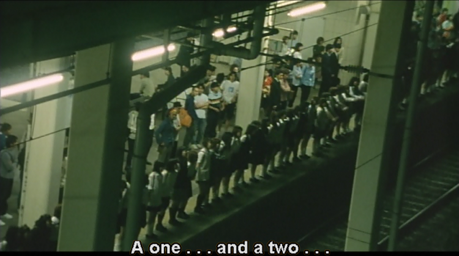
Suicide fever sweeps Japan, as school children leap from rooftops, plucky young women hang themselves in their living rooms, street vendors chomp pills on the job, and one particularly hilarious housewife happily mutilates herself as she prepares dinner. A mysterious website, composed entirely of red and white dots (red for women, white for men) displays the number of victims just before their suicides. The number continues to jump dramatically with each passing day. Are the suicides truly all connected, or are they copycats rippling out from the initial train jump? Is there a philosophy to the madness? A purpose? A message? Is there a central figure controlling this?
One steps forward in the figure of Genesis (rock star Rolly), the film’s pseudo-villain. Genesis looks like a cross between a Final Fantasy side character and Todd Haynes’ version of Glam rock. He has a small posse who claim to be the center of the Suicide Club and who run a sadistic ‘pleasure den’ in the basement of an abandoned bowling alley. After kidnapping some girls who have been communicating with the police about the Club, Genesis explains their motives to their captives via song— “Because the dead shine all night long.” The musical nonsequitor is funny and disconcerting, a strong stench of unreality after an hour of only whiffs.
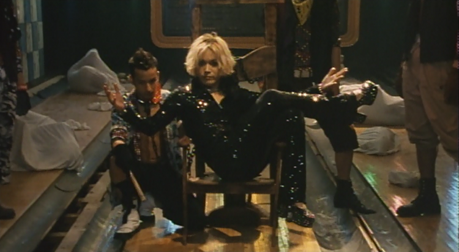
The suicides are also regularly punctuated by a group of singing 12 ½ year olds called Dessert, whose innocuous tunes underscore the chaotic narrative. The film’s semi-heroine (nothing is so black and white as to say “villain” or “hero” in Suicide Circle) discovers an alarming link between the pre-pubescent group, who seem to have a monopoly on pop music in Japan, and the suicides, but the link is never fully explained, even after a trip into the den of the children. Suicide Circle could have easily become a conventional and relatively successful horror/thriller, but it strays from the primary question—“what is the suicide club?”—to instead focus on tempering the film’s atrocities with hallucinogenic and tranquil interludes.
Disturbing imagery abounds, and the film’s off-orange blood and miniscule budget hardly dampens its efficacy. There are rolls of stitched together human flesh (gathered from living volunteers no less), wiggling bags of kidnapped humans and tortured animals, not to mention the mass suicide that opens the film. This is a movie that is not for everyone. I actively seek out controversial and disturbing films and found a lot of the images and ideas presented in Suicide Circle to be nauseating. If you can handle the imagery (and the unruly narrative), Suicide Circle is well worth your time. I’m not here to tell you whether Suicide Circle is a ‘good’ or ‘bad’ movie– those judgments are useless for most films, and doubly so for something like Suicide Circle. Like one of my personal favorites, Lars von Trier’s Antichrist, Suicide Circle is a film that demands to be seen.
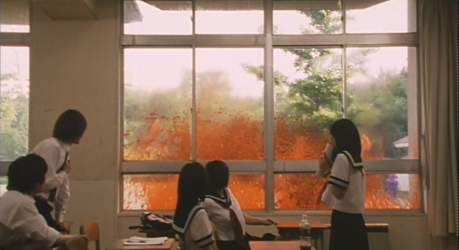
There’s a good deal of humor to be found in Suicide Circle, albeit a bloody gallows humor. The aforementioned housewife elicits shocked and disgusted laughter, as does Genesis’ out of place camp style and song. While the detectives try to identify the next suicides by their tattoos, everyone has the same tacky, cheap style of tattoo, which makes their job frustratingly, and amusingly, impossible. Suicide Circle’s funniest moment comes as a small clan of determined women pump each other up to hang themselves. “Don’t leave to tomorrow what you can do today!” The leader encourages, “We’re all sinners!” A hanger-on cries out in agreement, “I used to shoplift!”
Despite the humor and over-the-top events, Suicide Circle is ultimately a sad film. “Are you connected to yourself?,” one of the creepy children asks a policeman. It’s the sort of metaphysical question that plagues those with depression, the kind of self-doubting terror that infuses suicide. People on the street hold up signs telling others to “wake up” and to “jump here.” I came to wonder if this was even a conspiracy, or just a mass metaphysical crisis. It’s as if the entire country was on the edge of a building, waiting for a reason to jump.
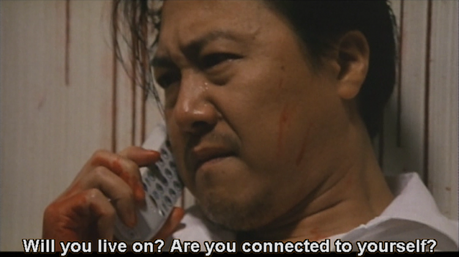
A simultaneous and strange (at times tongue-in-cheek) reactionary fear runs through Suicide Circle. This streak is the sort of age-old worry about what the media is doing to our children: innocuous pop songs can drive kids to murder, and the internet (where anyone can be hiding behind a single red dot) can drive them to suicide. At the end of the film, Dessert themselves sing it best as they croon, “Every day we’re pressing the keys that execute a million commands.” Despite the insipid song context, it’s difficult to imagine the lyrics as anything but a direct, gloating statement from the Suicide Club themselves.
The film could be a contemporary urban legend, a wildfire rumor about the power of peer pressure and hidden messages in pop songs. The underground ‘pleasure chamber’ of Genesis is straight from the nightmares of suburban moms, fears of sadistic high school dropouts running amok in depraved dens of sin. The film’s small details—a smashed ear being scrapped off a high-school window ledge, rolls of skin left in white duffle bags, a minimal website marking the suicides before they occur—could all be straight from urban legend. Like the businessman waking up in the tub full of ice, these are the sort of details that are inserted into folklore to make it sound more real. Suicide Circle‘s violence has no true epicenter, and for all of his bravado, we sense Genesis’ specialty is torture, not brainwashing. Like legend or mass hysteria there is no one origin.
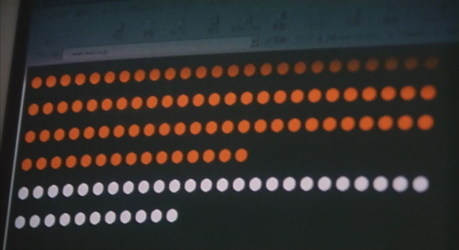
Ultimately, nothing at all is resolved in Suicide Circle. I could relate the entire film scene by scene and would spoil nothing. There’s simply nothing to spoil. No big reveal, no great “a-ha!” moment, no coming together of plot ends. Like suicide itself, Suicide Circle is unexplained– indeed inexplicable. You can recount all of the days and months leading up to a suicide, to try to make sense of it, but find nothing, no moment when it all makes sense. The very fabric and structure, the anatomy, of Suicide Circle is infused with this feeling. Like life, Suicide Circle simply begins and ends. One moment it’s there, and the next it’s gone.
Britta R. Moline 2/13/11

